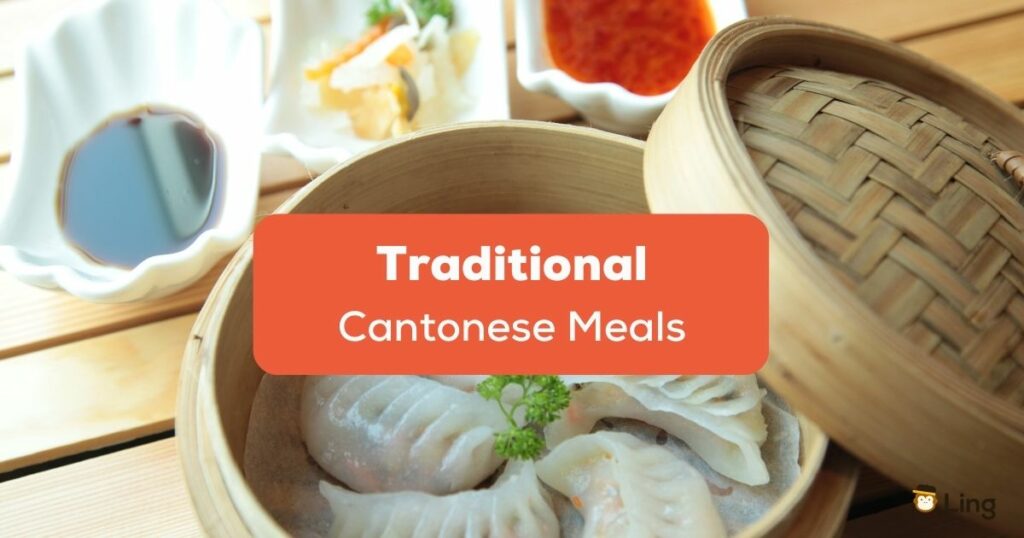Craving some authentic and traditional Cantonese meals? Here’s a quick list of must-try Cantonese meals that will surely satisfy your taste buds.
What comes into your mind when you think about your favorite Chinese restaurant? What Chinese food can you think of? Dim sum, soup dumplings, rice porridge, steamed fish, and other Chinese dishes that we enjoy; who will think that it all came from the Guangdong Province in Southern China?
In this blog, let’s satisfy our cravings by learning about traditional Cantonese meals filled with signature Cantonese flavors.
The Cantonese Cuisine
Cantonese food became systematic from the 19th century until the present. At that time, a great number of people from Guangdong immigrated to the west and founded Chinese restaurants serving Cantonese food, which has remained the most popular Chinese cuisine in the globe to this day.
Cantonese flavor is characterized as natural, fresh, mild, and slightly sweet, very different from the taste of Chinese food, such as the Sichuan style. Cantonese chefs seek to keep the authentic flavor of the meal while bringing out the natural flavor of the meat, veggies, and fruits. These recipes are prepared without the use of grease or other dairy products.
Cantonese cuisine’s most common cooking methods are steaming, stir-frying, and roasting. Other popular foods include roast duck, chicken, pork belly and char siu pork, sweet and sour dishes, and many more.
Currently, Cantonese foods and Cantonese recipes are one of the most popular dishes in the world.
What Are The Traditional Cantonese Meals In The Cantonese Cuisine
The Cantonese term for meal is 餐 (caan1). Now that you know some important information about Cantonese cuisine let us learn some traditional Cantonese meals and other related vocabulary.
1. Cantonese-Style Fried Rice – 廣式炒飯 (Gwong2 Sik1 Cau2 Faan6)
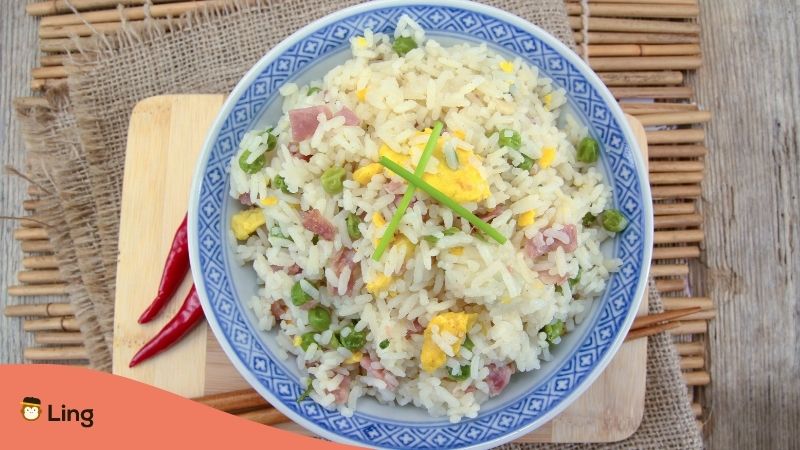
The first classic Cantonese dish that we’ll talk about is Cantonese-style fried rice. This is indeed one of the most popular Cantonese dishes that you can see in our favorite Chinese restaurants.
This dish, known in Cantonese as “炒飯 (Chao Fan)” or “stir-fried rice,” is a fantastic classic. At home, we prefer it as a complete dinner that can be quickly prepared when there is leftover rice, and we don’t have time to prepare something more elaborate. It may also be served with meat and/or soup.
Related Vocabulary
| Cantonese | Romanization | English Translation |
| 飯 | faan6 | rice |
| 炒飯 | caau2 faan6 | fried rice |
| 剩下 | zing6 haa6- | leftover |
| 肉 | juk6 | meat |
| 煎炒 | zin1 caau2 | stir-fry |
2. Choy Sum in Oyster Sauce – 蠔油菜心 (Hou4 Jau4 Coi3 Sam1)
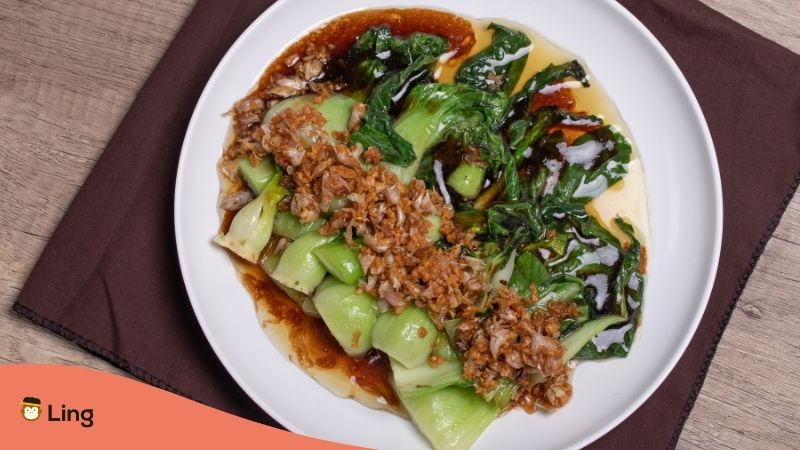
As its name suggests, Hong Kong Choy Sum is a green leafy vegetable that originates in Hong Kong and has broad leaves and thick stalks. The Chinese Flowering Cabbage is another name for this vegetable. You can eat the whole thing, from the stem to the leaves to the flowers, in a stir-fry, blanched, or even raw.
One of the sweetest-tasting Chinese leafy green vegetables is Chinese yu choy, particularly when it is selected when it is young and fresh. Although it is less prevalent than the Chinese Broccoli with Oyster Sauce that we find more frequently, you may have seen this vegetable served with oyster sauce and lightly blanched at dim sum restaurants.
Related Vocabulary
| Cantonese | Romanization | English Translation |
| 白灼 | baak6 coek3 | blanching |
| 菜心 | coi3 sam1 | Hong Kong Choy Sum |
| 蠔油 | hou4 jau4 | oyster sauce |
| 蔬菜 | so1 coi3 | vegetable |
| 菜 | coi3 | vegetables |
3. Steamed Egg – 蒸水蛋 (Zing1 Seoi2 Daan2)

If you’ve ever had Chinese steamed egg, which is sometimes called egg custard, you’ll be blown away by how smooth and fresh it tastes.
The perfect steamed egg from China, which is soft, smooth, and tender, is comfort food for many Chinese children and a dish that saves time for home cooks. We love to steam an egg in a small bowl and serve it as a side dish or make a big bowl for the whole family to share.
Related Vocabulary
| Cantonese | Romanization | English Translation |
| 蛋 | daan2 | egg |
| 新鮮 | san1 sin1 | fresh |
| 軟 | jyun5 | soft |
| 滑 | waat6 | smooth |
| 嫩 | nyun6 | tender |
4. Sweet and Sour Pork – 咕嚕肉 (Gu1 Lou1 Juk6)

Everyone knows what sweet and sour pork is. It’s a famous dish worldwide, and most cultures have their own way of making it, which I think is great! Tangsuyuk is the Korean version, Subuta is the Japanese version, and the Caribbeans have their own version.
Sweet and sour pork is a well-known Cantonese dish that both kids and adults love. The pork is perfectly breaded and fried, and the sauce is a delicious mix of pineapple juice, soy sauce, and other flavors. Overall, this recipe is a hit for everyone. The delicious pork can please even the pickiest eaters in China and the rest of the world.
Related Vocabulary
| Cantonese | Romanization | English Translation |
| 甜 | tim4 | sweet |
| 酸 | syun1 | sour |
| 菠蘿汁 | bo1 lo4 zap1 | pineapple juice |
| 豬肉 | zyu1 juk6 | pork |
| 醬油 | zoeng3 jau4 | sauce |
| 豉油 | si6 jau4 | soy sauce |
| 煎 | zin1 | to fry, to pan fry |
5. Shrimp Dumplings – 虾饺 (Haa1 Gaau2)
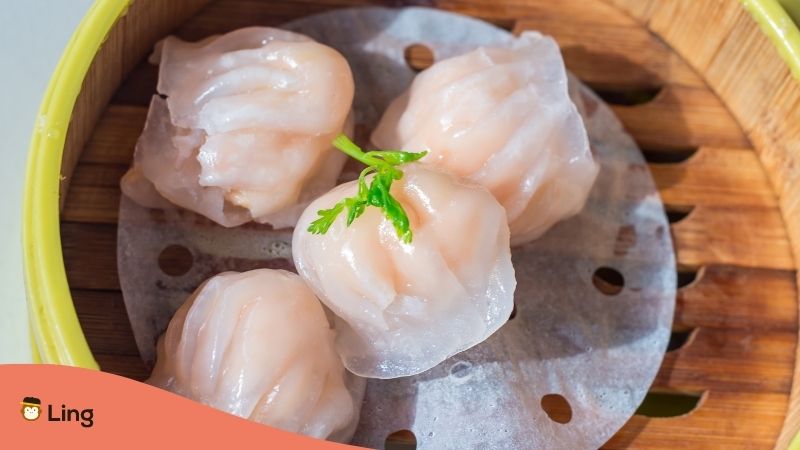
Har Gow (dim sum shrimp dumplings) are a pleasure to eat and look at. They have a juicy filling wrapped in thin, clear skin. Har Gow is different from other Chinese dumplings because its skin is thin and see-through. This is why Har Gow is also called “crystal shrimp dumpling (水晶虾饺)” on many menus.
Related Vocabulary
| Cantonese | Romanization | English Translation |
| 餃子 | gaau2 zi2 | dumplings |
| 蝦 | haa1 | shrimp |
6. Steamed Pork Buns – 叉烧包 (Caa1 Siu1 Baau1)
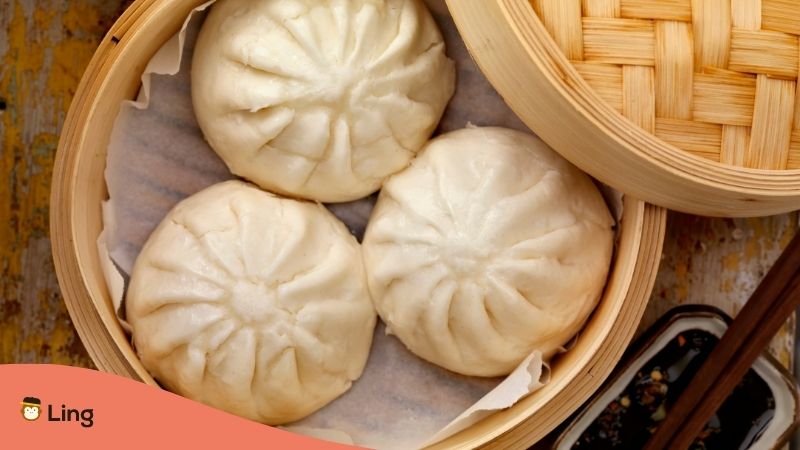
Another crowd’s favorite in Cantonese cuisine is the steamed pork buns (叉烧包 Caa1 Siu1 Baau1). As far as traditional Cantonese dim sum goes, Char Siu Bao/Char Siu Pao/Cha Siu Bao is unrivaled in popularity. An exquisite and exotic meal of dim sum can be among the best you’ve ever had. The meaty filling, soy-based thick gravy, and pillowy bun come together in a harmonious symphony of flavor.
Cha Siu Bao is barbecued pork in a bun. Chinese people call barbecued pork Char Siu which is where the name Cha Siu Bao comes from. Most people eat this pork bun in the morning or early afternoon. It is usually served with Chinese tea, which people in Hong Kong call yum cha (drinking tea). Today, many Chinese restaurants all over the world have lunch menus with barbecue on them.
| Cantonese | Romanization | English Translation |
| 蒸 | zing1 | steam |
| 餡料 | haam6 liu6*2 | filling |
| 飲茶 | jam2 caa4 | drinking tea |
7. Cantonese Steamed Fish – 蒸魚 (Zing1 Jyu4)
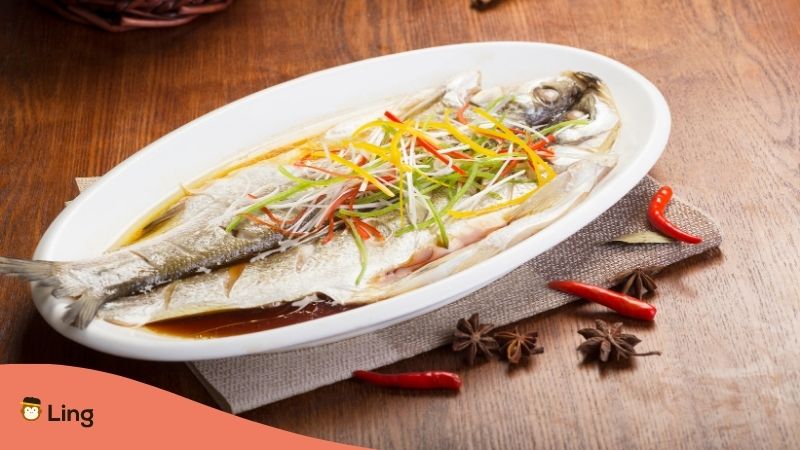
Cantonese steamed fish is a simple, traditional dish that is often one of the last dishes at a Chinese banquet (right before the last rice and noodle course). Finished with a light soy sauce, Cantonese Steamed Fish is a healthy and simple dish suitable for any occasion.
If it’s served at Lunar New Year banquets, you know it’s something special. Despite being a staple at any and all family gatherings, Cantonese Steamed Fish with Ginger and Shallots is still modest enough to be enjoyed as part of a simple weeknight spread.
Related Vocabulary
| Cantonese | Romanization | English Translation |
| 魚 | jyu2 | fish |
| 薑 | goeng1 | ginger |
| 蔥頭 | cung1 tau4 | shallots |
8. Rice Rolls – 肠粉 (Coeng4 Fan2)
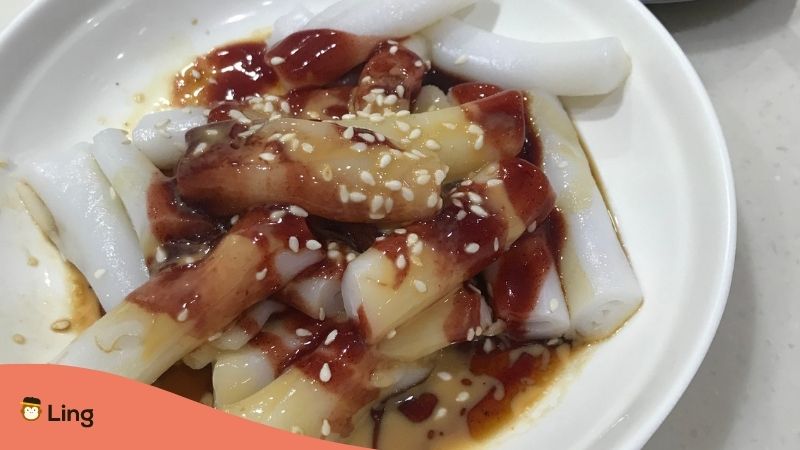
Cheung fun 肠粉 (Coeng4 Fan2) is a general term for sheets of rice noodles that have been rolled up. It can be used to talk about rice noodle rolls with or without fillings (shrimp, minced beef, or dried shrimp and scallions cooked into the rice noodles).
The rice noodle rolls are much easier to make than they look. All you have to do is make the batter and steam a thin layer of it at a time. Of course, it will take some time to make the cheung fun. But when you bite into one of the tender rice noodle rolls, you’ll know it was all worth it.
Related Vocabulary
| Cantonese | Romanization | English Translation |
| 米粉 | mai5 fan2 | rice noodles |
| 蔥 | cung1 | scallions |
| 牛肉 | ngau4 juk6 | beef |
9. Wonton Noodles – 云吞面 (Wan4 Tan1 Min6)
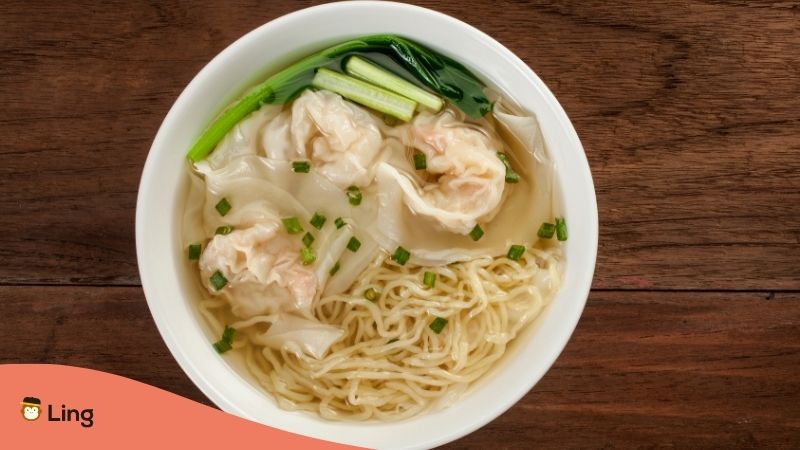
Cantonese Wonton Noodle Soup is a simple, easy-to-understand bowl of noodles you can get at most Cantonese restaurants. But if you don’t live near Chinatown or a Cantonese restaurant, you’ll want to try it at home.
Making Cantonese wonton noodles is traditionally an art. Fresh flour and eggs make the wonton wrappers and noodles. Fresh shrimp and pork flavor the wontons. Soup made with pork stock, dried fish, and shrimp. Slow-cook until translucent, light amber color. Each sip of the mild hot broth smells like a sea breeze.
Related Vocabulary
| Cantonese | Romanization | English Translation |
| 漿 | zoeng1 | broth |
| 猪肉汤 | zyu1 juk6 tong1 | pork stock |
| 雲吞 | wan4 tan1 | wonton dumpling |
| 鹹魚 | haam4 jyu4*2 | dried fish/ salted fish |
10. Char siu – 叉烧 (Caa1 Siu1)
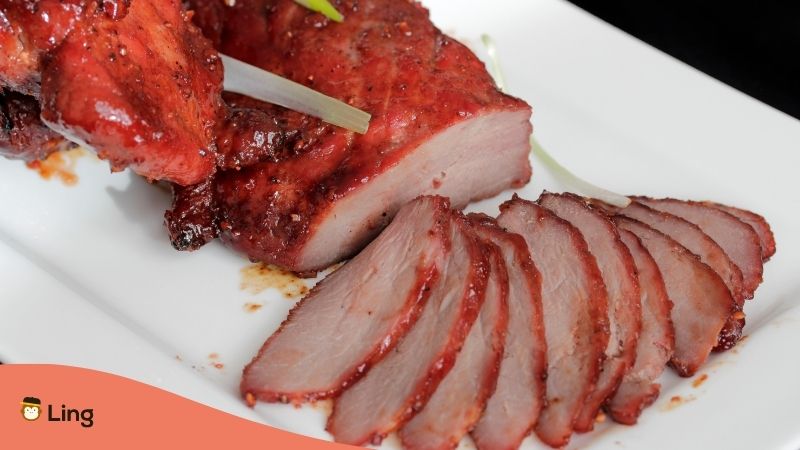
Char siu (叉烧) is a type of roasted meat from Cantonese cuisine. It is made by marinating pork in a sweet barbecue sauce and then roasting it. Over time, the char siu (叉烧) you can get in noodle shops and roast meat restaurants in Chinatowns all over the world has taken on a distinctive sweet flavor. But many restaurants today don’t use enough spices.
A good Char siu recipe has a rich flavor, with a balance of salty and sweet flavors, as well as a dash of spiciness that complements the pork and allows it to stand alone with blanched Choy sum and steamed rice.
Related Vocabulary
| Cantonese | Romanization | English Translation |
| 燒烤醬 | siu1 haau1 zoeng3 | BBQ sauce |
| 醃 | jip3 | marinate |
| 燒味 | haau1 | roast |
| 燒味 | siu1 mei2 | roasted meat |
| 咸 | haam4 | salty |
11. Stewed Beef Brisket – 柱侯牛腩 (Cyu5 Hau4 Ngau4 Naam5)
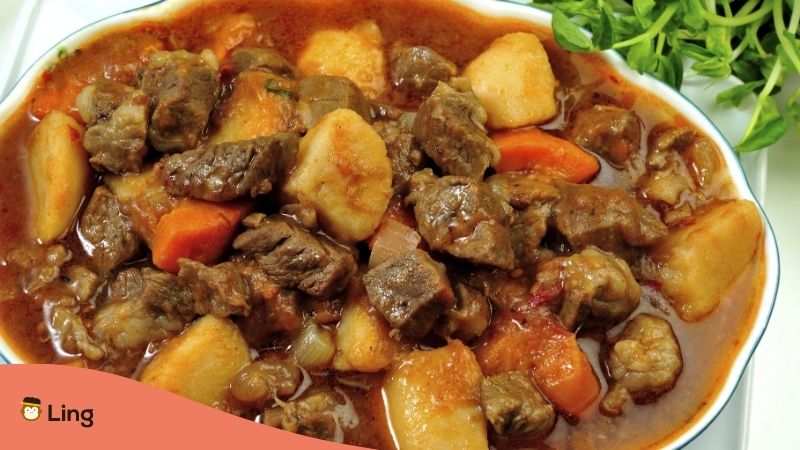
A hearty bowl of braised brisket stew, seasoned with onions, garlic, and bay leaves, is the perfect way to warm up on a chilly winter day. Beef stew is the quintessential winter warmer. It is a deliciously tender beef that has been slowly cooked in a rich beef broth.
Related Vocabulary
| Cantonese | Romanization | English Translation |
| 大蒜 | daai6 syun3 | garlic |
| 煲 | bou1 | stew |
| 洋葱 | joeng4 cung1 | onion |
12. Beef Chow Fun – 乾炒牛河 (gon1 caau2 ngau4 ho2)
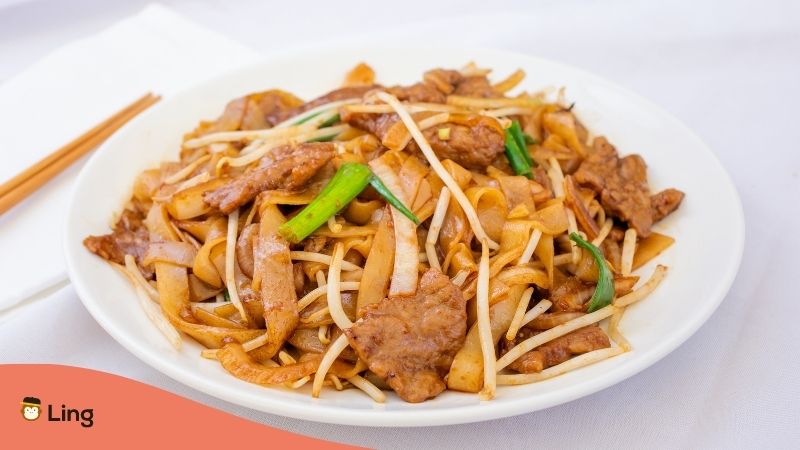
Beef chow fun, a popular Cantonese dish, is made by stir-frying beef with wide rice noodles, ginger, scallions, bean sprouts, and dark soy sauce. Cantonese roasted meat restaurants and dim sum restaurants often serve this dish.
Related Vocabulary
| Cantonese | Romanization | English Translation |
| 芽菜 | ngaa4 coi3 | bean sprout |
| 老抽 l | lou5 cau1 | dark soy sauce |
| 薑 | goeng1 | ginger |
| 燒味 | siu1 mei2 | roasted meat |
13. Lo Mein – 撈麵 (Lou1 Min6)
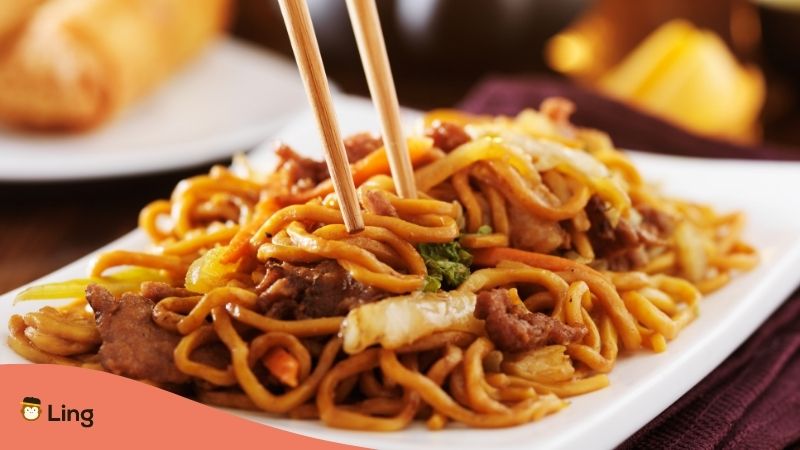
Lo mein is essentially just tossed or mixed noodles. Vegetables and protein, like chicken, beef, pig, shellfish, or tofu, are typically seen in lo mein dishes. Lo mein is essentially a dry version of classic noodle soup.
This is a type of noodle soup that is usually served dry. The soup is just served on the side, separate from the noodles and other ingredients.
Related Vocabulary
| Cantonese | Romanization | English Translation |
| 拉麵 | laai1 min6 | noodles |
| 雞肉 | gai1 juk6 | chicken (meat) |
| 豆腐 | dau6 fu6 | tofu |
| 貝類 | bui3 leoi6 | shellfish |
14. Cantonese Roast Duck – 燒鴨 (Siu1 Aap3)

Chinese roast duck, often known as Cantonese roast duck, is a form of Siu mei. These are marinated meats that are roasted over an open flame or on a rotisserie spit. They have a strong BBQ flavor and are coated with specially made-sauces. Siu mei is a traditional dish in Hong Kong. Sui mei is expected to be eaten every four days by the average resident.
Siu mei is frequently sold alongside other Cantonese-style preserved meats and pickles in Chinese BBQ restaurants. Although similar in appearance, Chinese Roast Duck and Peking Duck are not the same things.
Related Vocabulary
| Cantonese | Romanization | English Translation |
| 鴨 | aaap3 | duck |
| 燒味 | siu1 mei2 | roasted meat |
| 海鮮 | hoi2 sin1 | seafood |
15. Chicken In Soy Sauce – 豉油雞 (Si6 Jau4 Gai1)

Soy sauce chicken is a classic dish that is tasty, comforting, and easy to make in many different ways. Soy sauce chicken, which in Cantonese is called See Yao Gai, is a classic dish that many people love. Although not cooked in an oven or over an open fire like Char Siu, roast goose, etc., it’s considered to be a Siu Mei dish sold at Cantonese-style BBQ shops.
Related Vocabulary
| Cantonese | Romanization | English Translation |
| 焗爐 | guk6 lou4 | oven |
| 好味 | hou2 mei6 | delicious; tasty |
| 豉油 | si6 jau4 | soy sauce |
16. White Cut Chicken – 白切雞 (Baak6 Cit3 Gai1)
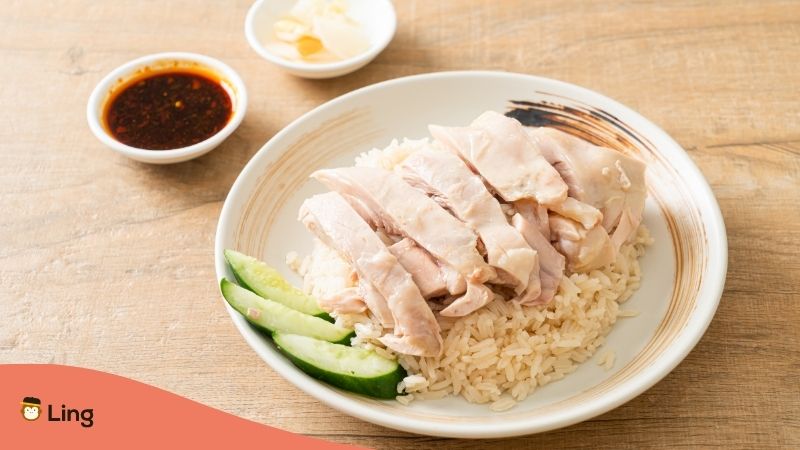
In Chinese culture, there are many sayings and beliefs about chicken that have to do with luck, money, and being strong. White Cut Chicken with Ginger Scallion dipping sauce is indeed one of the most popular Cantonese traditional meals. This delicious dish is made of a whole chicken poached with ginger and scallions, basted in sesame oil. It is served with a ginger scallion dipping savory sauce.
Related Vocabulary
| Cantonese | Romanization | English Translation |
| 雞肉 | gai1 juk6 | chicken (meat) |
| 芝麻油 | zi1 maa4 jau4 | sesame oil |
| 醬油 | zoeng3 jau4 | sauce |
17. Congee With Lean Pork And Century Egg – 皮蛋瘦肉粥 (Pei4 Daan2 Sau3 Juk6 Zuk1)
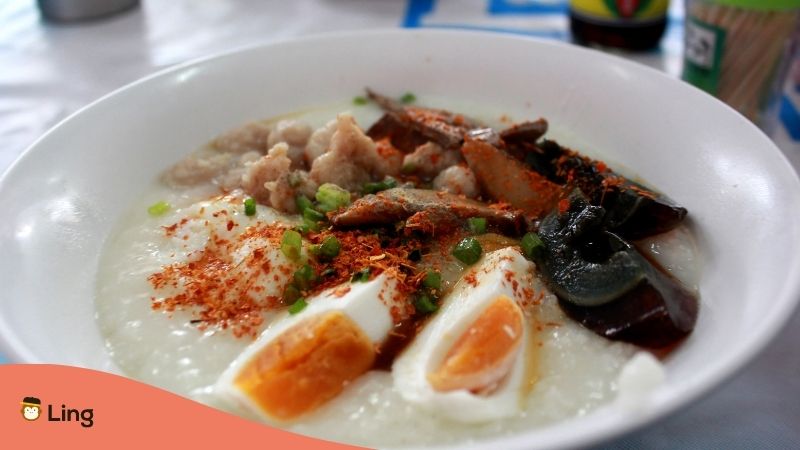
The Cantonese Century Egg and Pork Congee is the creamiest congee you will ever eat. It is slow-cooked until it is smooth and silky, and then it is mixed with tender spare ribs that melt off the bone.
If you’ve never had congee, it’s a rice porridge made with rice and water that’s pronounced ‘jook’ in Cantonese. The cooking method is similar to that of porridge, in that the mixture is boiled and stirred over a stovetop until the grains and water have broken down.
Related Vocabulary
| Cantonese | Romanization | English Translation |
| 蛋 | daan2 | egg |
| 粥 | zuk1 | porridge |
| 排骨 | paai4 gwat1 | spare ribs |
18. Stir-fried Water Spinach With Shredded Chilli And Fermented Tofu – 椒絲腐乳通菜 (Ziu1 Si1 Fu6 Jyu5 Tung1 Coi3)
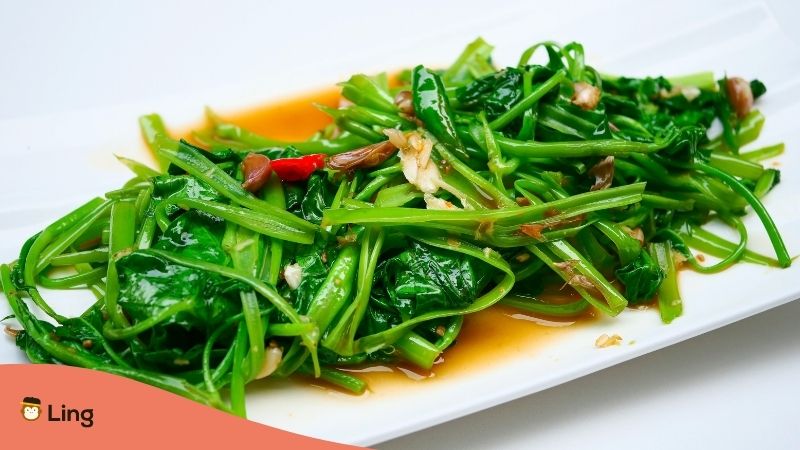
If you want to know what Chinese side dish is usually served with dinner, you’ll find the answer right here. Stir-fried water spinach with fermented bean curd is a family favorite that is colorful and very tasty. You could eat it every day if you want to.
Water spinach is a tropical plant with delicate leaves and shoots that grows in water or damp soil. Its mild flavor makes it popular for stir-fries.
Related Vocabulary
| Cantonese | Romanization | English Translation |
| 菠菜 | bo1 coi3 | spinach |
| 發酵 | faat3 gaau3 | ferment |
| 腐乳 | fu6 jyu5 | fermented bean curd |
19. Steamed Ground Pork with Salted Duck Egg – 鹹蛋蒸肉餅 (Haam4 Daan2 Zing1 Juk6 Beng2)
One of Hong Kong’s staple foods is steamed pork (蒸肉餅 Haam4 Daan2 Zing1 Juk6 Beng2). Steamed pork is so adaptable that every family has their own way of making it. Mastering the fundamental procedure opens up a world of opportunity. You can adjust the proportions of the ingredients to your liking. Preserved vegetables, shiitake mushrooms, or squid can be used to make alternative versions.
Related Vocabulary
| Cantonese | Romanization | English Translation |
| 冬菇 | dung1 gu1 | shiitake mushrooms |
| 魷魚 | jau4 jyu2 | squid |
| 冬菜 | dung1 coi3 | preserved vegetables |
20. Glutinous Rice Balls – 湯圓 (Tong1 Jyun4)

This dish, whose name translates to “soup balls,” is commonly served at family gatherings to symbolize harmony and unity. These chewy dumplings can be filled with black sesame paste or chopped peanuts, two ingredients that are common in many Chinese New Year dishes.
Arriving in time for this dessert, whose name sounds like tyun4 jyun4 (團圓), meaning “to be reunited,” is essential even if you miss out on other parts of the traditional large family meal. When it comes to tong1 jyun2, most households have one aunt or grandmother who is the go-to expert.
Related Vocabulary
| Cantonese | Romanization | English Translation |
| 花生 | faa1 sang1 | peanut |
| 黑芝麻 | hak1 zi1 maa4 | black sesame |
| 糯米飯 | no6 mai5 faan6 | glutinous rice/ sticky rice |
21. Egg Tart – 蛋挞 (Daan2 Daat3)
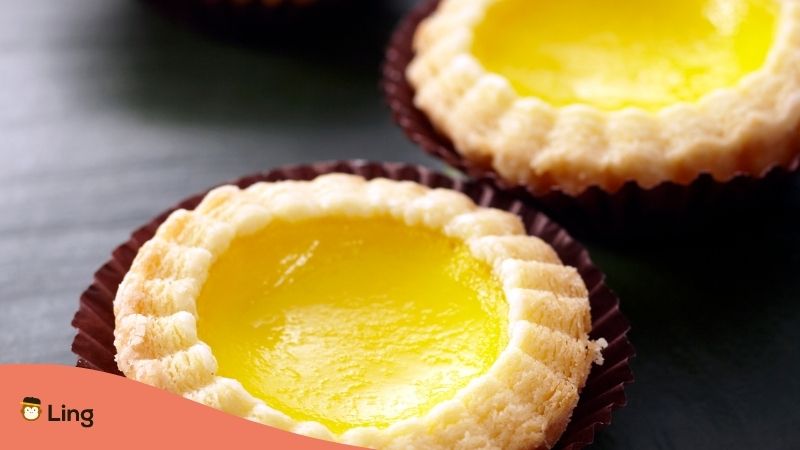
Now, let us go to a sweet treat. Do you have any experience with Hong Kong egg tarts? There are two distinct varieties of egg tarts that are favorites in China. The Portuguese egg tart is characterized by a thin, layered, and crisp pastry shell that is caramelized on top. The other one is the traditional Hong Kong egg tart which is less sweet than the American version and is known for its flaky, crumbly pastry crust.
It’s important to get a few things just right if you want your Hong Kong egg tarts to turn out to taste amazing. The tart’s crust, which is layered and incredibly thin, is a work of art. It’s crisp, but not too much so, and it’s also tender and juicy. You could easily wash down the filling with a glass of milk because it is so mild, creamy, and subtly sweet.
Related Vocabulary
| Cantonese | Romanization | English Translation |
| 糕 | gou1 | pastry |
| 牛奶 | ngau4 naai5 | milk |
| 焦糖 | ziu1 tong4 | caramel |
| 芥末醬 | gaai3 mut6 zoeng3 | custard |
Cantonese Vocabulary Related To Cantonese Meals
Now that you have learned different traditional meals, here are some related vocabularies that you might want to learn.
Ingredients and Sauces
| Cantonese | Romanization | English Translation |
| 配料 | pui3 liu6*2 | ingredients |
| 麵包 | min6 baau1 | bread |
| 韭菜 | gau2 coi3 | garlic chives/Chinese chives |
| 烹飪 | paang1 jam6 | cooking |
| 食油 | sik6 jau4 | cooking oil |
| 糯米粉 | no6 mai5 fan2 | glutinous rice flour |
| 海鮮醬 | hoi2 sin1 zoeng3 | hoisin sauce |
| 碎肉 | seoi3 juk6 | minced pork/minced meat |
| 白飯 | baak6 faan6 | plain white rice |
| 泡菜 | paau3 coi3 | pickled vegetables |
| 小菜 | siu2 choi3 | small side dishes |
| 醬油 | zoeng3 jau4 | sauce |
| 上湯 | soeng6 tong1 | soup stock |
| 小麥 | siu2 maak6 | wheat |
Meat
| Cantonese | Romanization | English Translation |
| 雞肉 | gai1 juk6 | chicken |
| 牛肉 | ngau4 juk6 | beef |
| 海鮮 | hoi2 sin1 | seafood |
| 豬肉 | zyu1 juk6 | pork |
| 魚 | jyu2 | fish |
Utensils And Things Found In The Kitchen
| Cantonese | Romanization | English Translation |
| 煤氣爐 | mui4 hei3 lou4 | charcoal stove |
| 鑊 | wok6 | wok |
| 筷子 | faai3 zi2 | chopsticks |
| 菜刀 | coi3 dou1 | cleaver |
| 砧板 | zam1 baan2 | cutting board/chopping Board |
| 锅铲 | wo1 caan2 | wok shovel |
| 蒸笼 | zing1 lung4 | steaming basket |
| 煲仔 | bou1 zai2 | clay pot |
Flavors
| Cantonese | Romanization | English Translation |
| 濃味 | nung4 mei6 | rich flavor/ rich in flavor |
| 甜 | tim4 | sweet |
| 酸 | syun1 | sour |
| 鹹 | haam4 | salty |
| 苦 | fu2 | bitter |
| 辣 | laat6 | spicy |
Other Vocabularies
| Cantonese | Romanization | English Translation |
| 亞洲市場 | ngaa3 zau1 si5 coeng4 | Asian markets |
| 粵菜烹飪 | jyut6 coi3 paang1 jam5 | Cantonese cooking |
| 唐人街 | tong4 jan4 gaai1 | Chinatown |
| 大餐 | daai6 caan1 | course meal |
| 套餐 | tou3 caan1 | set meal |
| 急凍食品 | gap1 dung3 sik6 ban2 | frozen meals |
| 外賣 | ngoi6 maai6 | ready meal |
| 素食 | sou3 sik6 | vegetarian meal |
Meals Are Better With Company! Learn Cantonese Now!

There’s no doubt that Cantonese meals are delicious. But meals are best enjoyed with company. Imagine having conversations with newly-founded Hong Konger friends while eating Cantonese food. Isn’t that amazing? So, why not learn Cantonese with Ling app?
Ling app is one of the leading language learning apps that can help you learn a language in record time. It has well-developed features that will develop your language skills. With the Ling app, language learning can be both meaningful and enjoyable. So, start your first lesson with Ling app now!
